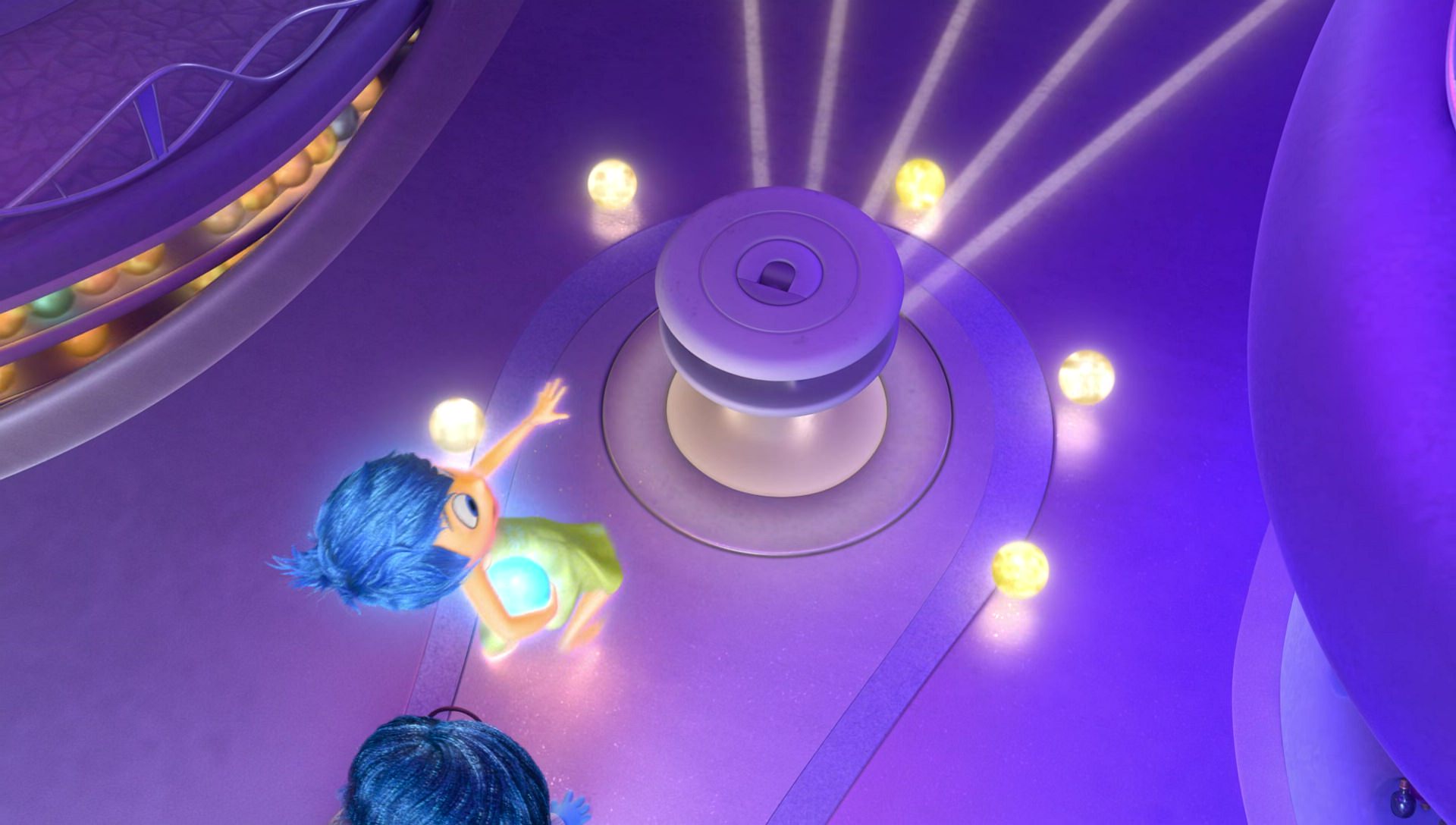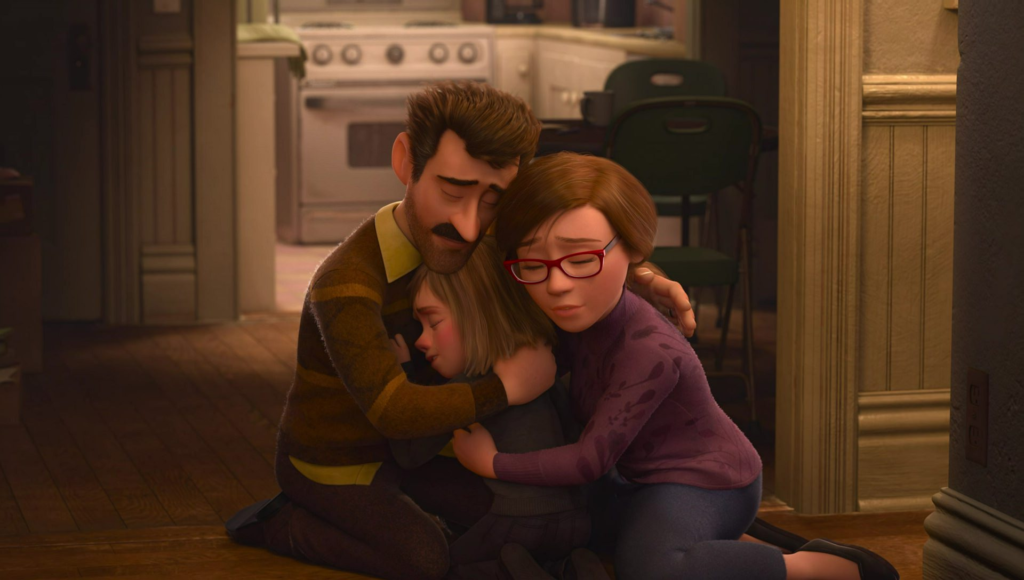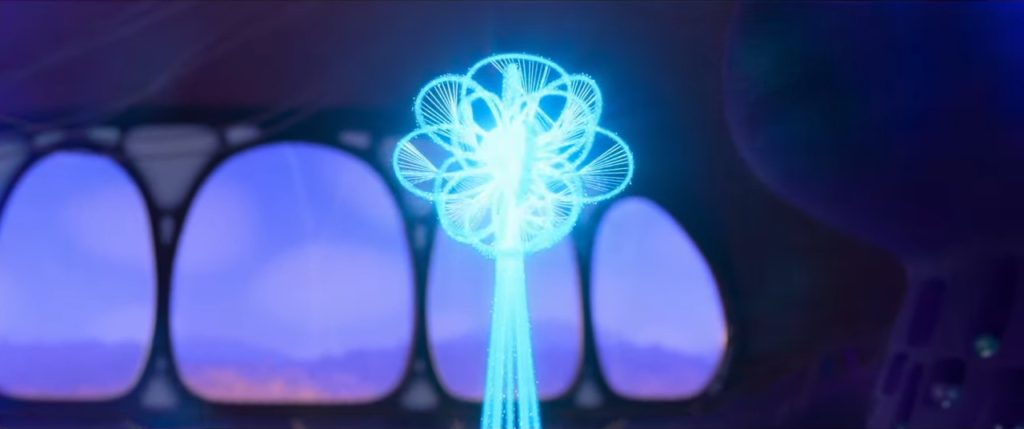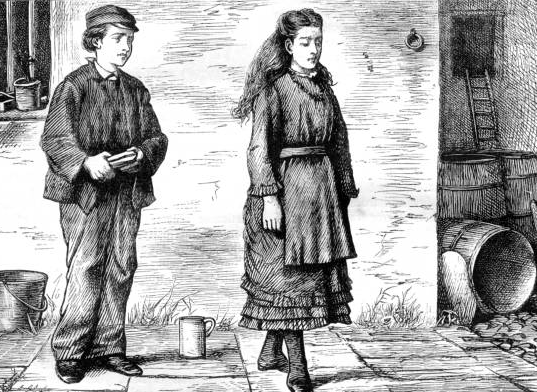I’m filing this post under Animation Station because it’s about an animated movie that’s not an adaptation of anything-two movies like that actually. But I will be writing about themes and messages they have in common with the works of Charles Dickens, adaptations of whose books I cover on this blog semi-regularly. It’s a weird post, I grant you, but no one else is going to blog about the thematic links between Pixar’s Inside Out films and Charles Dickens if I don’t do it.
To properly do so though, I’m going to have to get into major spoilers for the original Inside Out, its sequel, The Haunted Man and the Ghost’s Bargain, a novella Dickens wrote in the style of A Christmas Carol in Prose, and the longer and more famous novel Great Expectations. I won’t give away every detail of the plots, but I am going to get into climaxes and endings so consider yourselves warned.

For those of you not in the know, Inside Out takes viewers inside the mind of young Riley Andersen (voiced by Kaitlyn Diaz in the first movie, Kensington Tallman in the second) where the embodiments of five primal emotions, Joy (Amy Poehler), Sadness (Phyllis Smith), Fear (Bill Hader first movie, Tony Hale second), Disgust (Mindy Kaling first Liza Lapira second) and Anger (Lewis Black in both films) see what she sees, hear what she hears and drive her (sort of) through a console. They also collect memories each day, represented by glowing orbs the color of whichever emotion is associated with them. Special core memories power Riley’s Islands of Personality such as Goofball Island, Hockey Island and Family Island. Most of her early memories are happy. But when she’s eleven years old, Riley’s family moves from Minnesota where she’s lived all her life to San Francisco and the unpopular Emotion Sadness starts to touch Riley’s happy memories of her old home, turning them blue. Worse, she creates a sad core memory by making Riley break down crying in front of her new classmates. Joy tries to keep Riley’s personality from being changed by getting rid of the sad core memory. She accidentally ends up removing herself, Sadness and all of the core memories from Headquarters. The result is that Riley feels neither happy nor sad and can no longer enjoy any of the things that usually give her pleasure.

At first glance, the protagonist of The Haunted Man and the Ghost’s Bargain, Mr. Redlaw the melancholy chemist, has nothing in common with Joy. But at even a cursory second glance, he too seeks to remove unpleasant memories. He is a haunted man in two senses.[1]All five of Dickens’s Christmas novellas actually are about men who are haunted by something or other. He’s haunted in one sense by the fact that he was unloved by his parents, unlucky in love, betrayed by a close friend who also broke the heart of his beloved sister, a sister who died tragically-Phew! Clearly, few of his core memories are happy. He’s haunted in another sense by a grim phantom who appears to Redlaw in his own shape on Christmas Eve. The ghost offers him the ability to forget his sorrows, wrongs and troubles with the side effect that he will make anyone with whom he comes into contact forget theirs too. Tempting as this sounds, Redlaw feels a strong foreboding that it’s wrong but accepts the bargain anyway. “Who would not forget their sorrows and their wrongs?” he reasons. But the results prove disastrous. When Redlaw causes the many members of the struggling Tetterby family to forget their past struggles that bound them together, they resent their present struggles and, what’s more, resent the inconvenience of each other.[2]The Tetterbys make for interesting foils to the Cratchit family from Dickens’s most famous Christmas story. We never saw them fighting with each other and I don’t mean that as a criticism … Continue reading When Edmund Denham, an ill student of Redlaw’s, forgets his past sickness, he becomes cold and ungrateful to Milly Swidger, wife of Redlaw’s college’s caretaker, William Swidger[3]Sorry if it’s hard to keep all these characters and their relationships straight., who helped him through it. When William’s old father, Philip, forgets all the grief George, his more wayward son, caused him over the years, he counterintuitively feels disinclined to forgive him and when George forgets all the sorrow his sins have brought, he no longer feels repentant.

The idea that suffering strengthens the bonds between people, particularly family members, also turns out to play a big part in Inside Out. In one of the movie’s most powerful scenes[4]It may sound strange to describe a bouncy cartoon like this as emotionally powerful, but it earns the description., Joy accidentally rewinds a happy memory of Riley’s old hockey team cheering for her to its sorrowful beginning. The reason Riley’s parents (Kyle MacLachlan and Diane Lane) and teammates came to lift her spirts was that they saw she was deeply discouraged by a critical mistake she made on the ice. Without that, the joyful memory would never have been made. This inspires Joy to regretfully hand the core memories of Riley’s old life in Minnesota to Sadness, turning them blue. Riley tearfully confesses her homesickness to her parents, and they tell her they miss their old home too. As the Andersens share a group hug, Sadness gently takes Joy’s hand and places it on the console. Riley sighs with relief and smiles through her tears. A new core memory is created, one both golden and blue, happy and sad. It creates a new Family Island, one even bigger and stronger than the old version.

The Haunted Man and the Ghost’s Bargain also ends with memories and relationships restored. On Christmas Day, Milly Swidger is also able to remove the ghost’s “gift” from everyone by her mere presence. Apparently, she’s just that goodhearted. Err, yeah, that ending is rather anticlimactic and ridiculously convenient and the main reason The Haunted Man is not as great as A Christmas Carol.[5]It’s also odd since Milly interacted with all of the “forgetters” except for Redlaw himself the night before and lacked this power then. Apparently, she gained it after Redlaw … Continue reading Still, there’s poignancy in Milly acting as a go-between between Redlaw and the friend who betrayed him, gently asking for forgiveness for the man and even more in the revelation about her own memories of sorrow. Long ago, she and her husband lost their only child in its infancy. “When I see a beautiful child in its fond mother’s arms,” she says, “I love it all the better, thinking that my child might have been like that and might have made my heart as proud and happy. All through life, it seems by me to tell me something. For poor neglected children, my little child pleads as if it were alive and had a voice I knew with which to speak to me. When I hear of youth in suffering or in shame, I think that my child might have come to that, and that God took it from me in His mercy. Even in age and grey hair, such as father’s is at present: saying that it too might have lived to be old…and to have needed the respect and love of younger people.”

In Inside Out 2, Joy remembers the lesson she learned about every Emotion serving a purpose, but she seems to have forgotten her lesson about unpleasant memories serving a purpose too as she banishes them to the (literal) back of Riley’s mind. By contrast, she plants the memories she likes beneath Headquarters. They grow into beliefs which make up Riley’s belief system which, in turn, make up her Sense of Self.[6]This raises all kinds of questions. How come the Emotions didn’t know about this in the first movie? Wouldn’t the memories that create beliefs be the core memories? If they’re … Continue reading The Emotions pride themselves on thirteen-year-old Riley’s Sense of Self being a positive one. But the new Emotions, Anxiety (Maya Hawke) and Envy (Ayo Edebiri), threaten that.[7]I could also quibble with the idea that emotions like Anxiety, Envy, Embarrassment (Paul Walter Hauser) and Ennui (Adele Exarchopoulos) only arrive with puberty. Even in-universe, while such feelings … Continue reading Right before Riley and her best friends, Bree (Sumayyah Nuriddin-Green) and Grace (Grace Lu), attend a three-day hockey skills camp, she learns that they will be attending different high schools. Anxiety makes Riley’s main goal at camp be to get on her new school’s hockey team, the Fire Hawks. To do this, she suppresses the original five Emotions, sends Riley’s old Sense of Self to the Back of the Mind and creates a new one based on anxious memories and beliefs.

Pip, the protagonist of Charles Dickens’s Great Expectations, also suffers the loss of his positive sense of self in his youth. While he hadn’t had nearly as comfortable a childhood as Riley, he was once happy with his destiny of growing up to be apprenticed to his sister’s husband, Joe Gargery the blacksmith. But when he visits the beautiful, upper-class Estella and she snubs him, he becomes ashamed of his home. “I had believed in the best parlor as a most elegant saloon,” he laments in the book’s first-person narration, “I had believed in the front door as a mysterious portal of the Temple of State whose solemn opening was attended with a sacrifice of roast fowls; I had believed in the kitchen as a chaste though not magnificent apartment; I had believed in the forge as the glowing road to manhood and independence. Within a single year all that was changed. Now it was all coarse and common…” Happily, Riley doesn’t meet with the same kind of scorn that wounds Pip. Val Ortiz (Lilimar Hernandez), the star of the Fire Hawks with whom Anxiety drives Riley to spend most of camp schmoozing, is much more like genial, helpful Herbert Pocket, who shows Pip the ropes of being a gentleman when his wish to be one is unexpectedly granted, than like the cruel Estella.[8]Dani, another girl on the team (whose voice actress is unspecified in the credits for some reason) is harder on Riley but still not as bad as Estella or other snobby characters from Great … Continue reading But the same loss of innocence that Pip experiences when he plays cards with Estella, and she berates him for calling the knaves jacks can be seen in the scene of Riley realizing that her favorite band is seen as childish by the Fire Hawks. Just as Pip makes earning Estella’s approval the goal of his life, Riley makes hers earning the approval of the Fire Hawks. This leads her to pretend to disdain her aforementioned favorite band, eat energy bars that taste like cardboard and broccoli and even to shun Bree and Grace. (“Why are our best friends always trying to hang out with us?” Envy complains.) Pip likewise shuns Joe Gargery and Biddy, the lowly schoolteacher’s assistant who tutored him as a child, once he becomes a gentleman of expectations. When Joe pays him a visit, he confesses in the narration that “If I could have kept him away by paying money, I most certainly would have paid money.”

I recently wrote that I don’t understand why so many kids’ movies believe that the main thing children need to be warned against is self-doubt rather than pride. At first, Inside Out 2 seems to be one of those movies. Anxiety the antagonist takes away Riley’s sense that she’s a good person, replacing it with a sense of inadequacy, and the heroes’ goal is to restore the original sense of self. But the movie subverts this to a limited but surprisingly large extent. (Great Expectations with its guilt-ridden narrator doesn’t bother with it at all.) While the anxiety-fueled Sense of Self harms Riley, Joy finds that her earlier naive, arrogant sense of herself as a good person will no longer do either. Instead, Riley gains a third Sense of Self grown from the memories that formed the first two and the uncomfortable ones Joy initially sent to the Back of the Mind. Only then does she find peace. It turns out that Anxiety wasn’t entirely wrong when she said a more negative self-image could spur Riley to self-improvement. But instead of worrying about being a better hockey player or a member of the gentry, Riley and Pip realize they need to prioritize being better human beings. “I was such a jerk to you guys,” Riley says to Bree and Grace. “I’m so sorry! If you don’t want to be friends anymore, I get it. But I really hope that you can forgive me someday.” Pip says much the same thing to Joe and Biddy though he takes more words to say it. In both stories, the old friends forgive the protagonists and though their lives cannot return to exactly what they were before, the bonds between them remain strong. I’m reminded of a line from another animated movie. “The past can hurt. But the way I see it, you can either run from it or learn from it.”
Of course, Charles Dickens was also aware that obsessing over painful memories can have terrible consequences. The main villain of Great Expectations, Miss Havisham[9]Actually, a character called Compeyson is probably the real main villain, but Miss Havisham is the most developed antagonist and the one everybody remembers., relives the most miserable day of her life every day, making it define her whole identity and dedicating her life to avenging it. If her inner life were dramatized, Inside Out style, we’d see her Emotions constantly replaying the fateful day and brooding over it. Cleary, that’s not healthy. But Pip’s story, like those of Redlaw and Riley, shows that “bad” memories can also lead to empathy and repentance. I can think of no better way to close than with this quote from The Haunted Man. “Lord keep my memory green.” I’m sure the characters in Inside Out would agree with that sentiment though they would maintain that memories should be multicolored.

Next Week: Back to Narnia
References
| ↑1 | All five of Dickens’s Christmas novellas actually are about men who are haunted by something or other. |
|---|---|
| ↑2 | The Tetterbys make for interesting foils to the Cratchit family from Dickens’s most famous Christmas story. We never saw them fighting with each other and I don’t mean that as a criticism at all. One of the two scenes in which we saw them all together was a rare occasion when they could all take the day off and enjoy each other’s company. The other one had them grieving the death of one of their own. Showing them fighting wouldn’t have fit in. I’m sure Dickens still expected us to assume they fought amongst themselves now and then. With the Tetterbys we actually see them fighting amongst themselves and then apologizing and making up with each other. It’s a more complex look at a large and generally loving family struggling with a small income. |
| ↑3 | Sorry if it’s hard to keep all these characters and their relationships straight. |
| ↑4 | It may sound strange to describe a bouncy cartoon like this as emotionally powerful, but it earns the description. |
| ↑5 | It’s also odd since Milly interacted with all of the “forgetters” except for Redlaw himself the night before and lacked this power then. Apparently, she gained it after Redlaw listened to some Christmas music or something like that…Yeah, this book really isn’t as great as A Christmas Carol. |
| ↑6 | This raises all kinds of questions. How come the Emotions didn’t know about this in the first movie? Wouldn’t the memories that create beliefs be the core memories? If they’re buried, doesn’t that mean Riley can’t recall them? Oh well. Just don’t think about it much. |
| ↑7 | I could also quibble with the idea that emotions like Anxiety, Envy, Embarrassment (Paul Walter Hauser) and Ennui (Adele Exarchopoulos) only arrive with puberty. Even in-universe, while such feelings weren’t personified as characters, I got the impression Riley already experienced them. Anxiety was just Fear on a bad day. He and Disgust handled embarrassment between them. Since Inside Out connects Disgust with taste, she and Sadness were in charge of envy. And ennui was arguably conveyed by the absence of Sadness and Joy. If I were writing the sequel’s story, I would have had Fear undergo a Jekyll-and-Hyde transformation into Anxiety. Then again, that would have cost us Fear’s part in the story as it is and Maya Hawk’s vocal performance as Anxiety, so I’m willing to accept the movie as it is. |
| ↑8 | Dani, another girl on the team (whose voice actress is unspecified in the credits for some reason) is harder on Riley but still not as bad as Estella or other snobby characters from Great Expectations. |
| ↑9 | Actually, a character called Compeyson is probably the real main villain, but Miss Havisham is the most developed antagonist and the one everybody remembers. |
